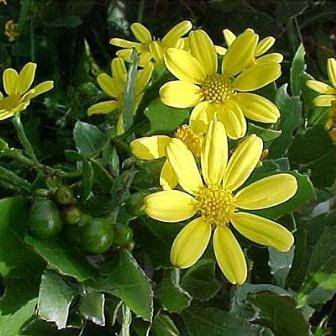The name Chrysanthemoides pertains to its likeness to the genus Chrysanthemum (meaning yellow flower), many of which are popular garden subjects.The specific name 'monilifera' means 'bearing a necklace' and pertains to the shiny, fleshy fruit arranged on the margins of the daisy flowers, like a necklace. This plant was named Osteospermum monilifera by Linnaeus in 1754. The present name was given by T. Norlindh in 1943.
Chrysanthemoides consists of 2 species, both endemic to southern & eastern Africa, both with fleshy fruit, immediately separating it from all other plants in the daisy family (Asteraceae) to which they belong. C. monilifera is a today a serious weed in Australia.
Chyrsathemoides monilifera is a fast growing perennial, semi-succulent, spreading to 2 m tall. Branches grey to grey-green, smooth ascending, fleshy at first becoming woody. The leaves are simple, alternately arranged, oval to to broadly lanceolate, fleshy and have short petioles of up to 10 mm long. The leaf blade are about 45 mm long and 24 mm broad green to grey green and the surface of the young leaves covered with dense cobweb-like hairs, becoming smooth with age. The flowers are borne on branch ends in groups of up to 5. The flowers are typical daisy-like (involucre) and up to 40 mm in diameter, bell-shaped and bright yellow. This larger 'flower' typical of the daisy family is made up of many individual densely arranged tubular male and female flowers and termed the involucre. The marginal female florets are sterile and each with a single yellow petal. The fruit is unique, deviating from all other members of the daisy family. It is fleshy, egg-shaped, edible and sweet, at maturity brown, blackish or purple and up to 6 mm in diameter.
The plant occurs in full sun in well drained situations such as coastal dunes, hills, mountains (fynbos, or grassland) or rocky terrain, often part of a natural shrubbery or sometimes growing as asolitary individual. It is a pioneer, often appearing after fires. Its life span is between 8-12 years, after which the plants become woody and untidy and are best replaced. Its semi-succulent nature makes it drought tolerant. The Afrikaans vernacular name bietou is derived from the original Khoi name. Although it may flower throughout the year, its main flowering time is during late autumn and winter. It is pollinated by insects and bees find it particularly attractive. The fleshy fruits, appearing shortly after the flowers, are very popular among frugatory birds.
You're buying a pack of 10 Seeds
We'll supply you with all the germination & care instructions.

